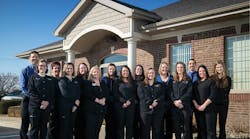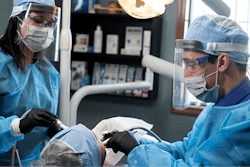Grabill, Indiana: population 1,053. Known for its antique stores and Amish farms, Grabill’s motto is Live a Bit of Yesterday. Ironically, the town is home to a rather high-tech dental practice. Lori Howard, LDH, works at Grabill Family Dentistry and is proud to share her op.
From the game room to the large saltwater aquarium, Lori says the patient waiting area is one of the first features patients enjoy. “We have a separate room with video games for patients of all ages to play,” she writes. “When patients leave the office, we have a saltwater aquarium for them to enjoy. They can try to find Nemo, Marlin, and Dory, along with other saltwater sea creatures in the tank.”
Once seated, patients have choices to help them relax. “For patients who are stressed for dental procedures, we find that establishing a rapport with them prior to their initial treatment visit helps ease their mind. We offer nitrous oxide and oral conscious sedation to our patients who need a little more help to relax. We apply topical and subgingival numbing gel and deliver local anesthetic to help ensure adequate anesthesia throughout their treatment. We encourage them to bring earbuds to listen to music, we offer to dim the lights, and we give them darkened eye protection, a blanket, and a neck pillow to make them as comfortable as possible.”
The eye protection Lori’s office uses (AllPro Protect-A-Lens Smoke Disposable Protective Eyewear) protects patients from debris during treatment and is disposable—there are no foggy, streaked glasses to sanitize between patients. “The tinted eyewear provides comfort and helps the patient to relax,” she says. “Patients frequently ask if they can take them home, and of course we say yes!”
The biggest change the dental practice has made recently is implementing the Safe Mercury Amalgam Removal Technique (SMART). This set of rigorous recommendations was created by the International Academy of Oral Medicine and Toxicology based on scientific research “[to reduce] the potential negative health outcomes of mercury exposure to patients, dental professionals, dental students, office staff, and others,” according to the SMART website.1“We believe it is our responsibility to offer the safest and most effective health solutions to our patients,” says Lori. “Though there is heated debate around mercury in our profession, we believe it speaks volumes that the EPA mandates that by 2020 all dental offices must install amalgam separators so mercury particulate does not enter community water systems. If we are not allowed to release it into public waters, why are we OK with allowing our patients and team members to swallow or inhale it?”
The recommendations suggest dental providers and patients wear protective gear and requires offices to have high-volume air filtration systems to prevent inhalation of fumes. “All the dental providers in the room wear charcoal masks, face shields, goggles, disposable gowns, surgical caps, and gloves,” says Lori. “The patient is given a slurry of charcoal and chlorella as an adsorbent to rinse and swallow before the procedure. The patient is covered with disposable protective gear and given a nasal mask that delivers oxygen. A dental dam is placed. During the amalgam removal, the dentist uses an oral aerosol vacuum two to four inches from the patient’s mouth to mitigate mercury exposure. After the procedure is completed, the patient’s mouth is rinsed with a slurry of charcoal. The implementation of the SMART protocol has drawn many patients seeking to have their amalgams removed safely. We are happy to offer this service to our patients.”
Lori also has praise for the new office x-ray machine. “One piece of equipment that we have added to our operatory that has impressed us with its efficiency and improved our ability to provide optimal patient care is the Planmeca ProMax 3D CBCT x-ray unit,” she says. “This unit is able to take 2-D and 3-D radiographic images using an ultralow-dose radiation protocol. We can take a CBCT scan of a single tooth that has the same radiation dose as a 2-D single PA. It is particularly helpful to diagnose failing endodontic treatment, cracked teeth, dental abscesses, extractions, and TMJ problems; locate mandibular nerves; treatment plan dental implants; and assess airway health.” The machine also gives a 2-D panoramic x-ray a clearer image for better diagnosis of pathology.
For preventive dentistry products, Lori says she and her colleagues recently began using the CariFree group of products. Each product has a different function: decrease bacteria, remineralize, and neutralize mouth pH. “One of the biggest differences between CariFree products and others is the increased pH neutralization, ranging from 8.0 to 11.0,” Lori said. “They have five critical elements: pH neutralization and antibacterial properties from hypochlorite, fluoride, nanohydroxyapatite, and xylitol. All of the products contain xylitol, and each product has a number that reflects the total number out of the five components that the product contains. We recommend the CTx4 treatment rinse to our periodontal maintenance patients due to its antibacterial agent. We also use this rinse to irrigate pocketing at their recare appointments. We dispense CTx3 as a daily fluoride mouth rinse. We also recommend CTx4 Gel 5000 as a replacement for daily toothpaste for patients who have high caries risk or active demineralized lesions.”Lori also says she likes to dispense Oral-B Complete Glide Dental Floss Picks with Scope. She says the floss slides easily into contacts and the pick at the end removes food particles.
For her own relaxation, Lori is a fan of yoga. “I have found it very therapeutic for my body,” she says. “It has helped my posture, muscle strength, and muscle tone and has led to reduced occupational pain. The improvement from yoga both physically and mentally is something everyone would benefit from.”
Good things often come in small-town packages. Thank you, Lori, for sharing your operatory!
Reference
1. Safe amalgam removal. International Academy of Oral Medicine & Technology website. https://iaomt.org/for-patients/safe-amalgam-removal. Accessed May 9, 2019.









